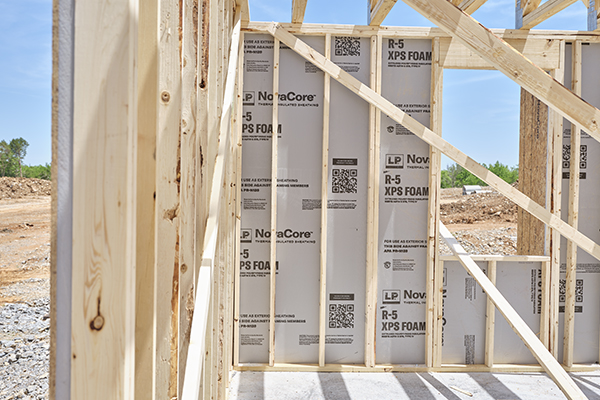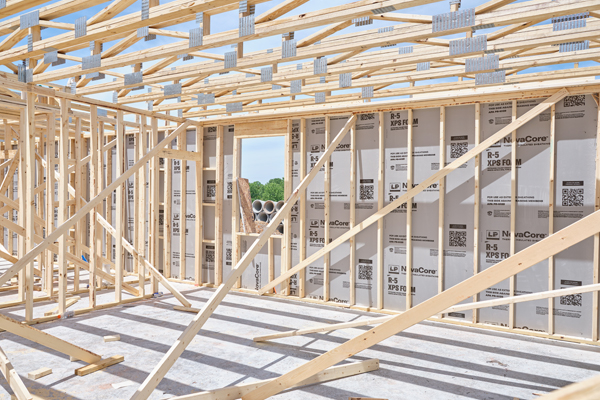Industry Trends8 min
Insulated Sheathing and Your HVAC: How the Two Work Together
When choosing an HVAC unit for a new construction home, “bigger” is not necessarily better. Insulation and HVAC are two systems that need to work together to create greater efficiencies and comfort for the occupants inside. It stands to reason that a more insulated home helps improve the overall efficiency of the HVAC—but why? And what happens when they don’t work well together?
How Insulation Works
While there are many insulation options available they all work to provide resistance to heat flow, which can help lower heating and cooling costs.
Heat flow involves three basic mechanisms:
Conduction is how heat moves through materials—like when a metal spoon gets hot when stirring hot coffee.
Convection is the way heat circulates through liquids and gasses and is why warmer, lighter air rises to the ceiling and cooler, denser air sinks toward the floor.
Radiant heat travels in a straight line and heats anything solid in its path that absorbs its energy.
Regardless of the type of heat, it’s always flowing—even indirectly through interior ceilings, walls and floors. Heat flow seeks cooler temperatures, which means heated inside air will flow into the unheated garage or outside during colder seasons. To maintain comfort, the heat lost in the winter must be replaced by the heating system. Likewise, during summer warm outside air flows into conditioned space, and without sufficient insulation the HVAC must work harder to maintain the comfort of the people inside.
How HVAC Works
Simply put, an HVAC system can heat a home by using a furnace to generate hot air or by using a heat pump, which provides heat or cool air depending on the exterior temperature (whether it is a cooler or warmer month). Air conditioning removes heat from the inside air and transfers it outside.
“Cooling is one of the most efficient processes we have because heating requires much more energy. Cooling does not,” explains Neil Friedberg, Building Science Manager at LP Building Solutions.
Integrating the Two Systems: HVAC and Insulation
The purpose of insulation is to slow the transfer of thermal energy from inside to outside during the winter or from outside to inside in the summer. Continuous insulated sheathing, like LP NovaCore™ Thermal Insulated Sheathing, offers an uninterrupted thermal barrier that helps eliminate heat loss, removing the path in or out of a home. While continuous insulation is required by code in some areas, it also decreases thermal bridging.

Thermal bridging happens when heat finds a path in or out of a building due to an interruption in, or insufficient amount of, insulation. In a wall, this heat transfer can occur through the studs or framing members.
“Continuous insulation looks at the entire wall as a system,” says Freidberg. “By reducing thermal bridging and increasing the overall R-value of the wall, you’re going to have a more energy-efficient home and use less energy to heat or cool that space.”
A well-insulated home with a better building envelope can also help reduce dramatic inconsistencies between hot and cold, helping stabilize temperatures inside the home.
Insulated Sheathing and Your HVAC
Now that you have a well-insulated home with insulated sheathing, HVAC size has to be considered. “Because the thermal load is decreased, you could reduce the overall size of your HVAC system,” says Friedberg. “In the summertime, you don’t want to over-cool your house and you also don’t want to overheat your home in the winter—this is called ‘short cycling.’”
Short cycling is when your HVAC is too big and it hits the temperature level so quickly that it doesn’t cycle long enough to maintain the moisture levels. Freidberg explains that high humidity in a home can make the occupants feel uncomfortable so the homeowner turns down the thermostat, which makes the HVAC run more frequently and could waste money in the long term.
Another disadvantage of having an oversized HVAC is the potential to over-pressurize the house, which pushes moisture through the walls. If it gets into the wood studs when temperatures decrease, the moisture can condense. Over time, if the wood doesn’t dry out it can rot.
“Without the appropriate insulation in your home, you’re going to have short cycling and other temperature reactions in your home. When you use LP NovaCore continuous insulation in addition to traditional cavity insulation to help your home, it benefits the performance of your HVAC by reducing thermal inefficiency,” says Friedberg.

The solution is to right-size your HVAC.
The rule of thumb is to calculate BTUs based on square footage. But Friedberg recommends finding a contractor who uses Manual J (load), D (design) and S (sizing) calculations, which helps them configure a well-designed system for performance, energy efficiency and homeowner comfort. Right-sizing often gives you a smaller unit, preferably a variable speed to cool as it needs but also dehumidify. “Also, a properly right-sized HVAC unit will last longer. Remember, the more stopping and starting your system does, the more wear you’re putting on parts. The motors, the capacitors, they are designed to run,” explains Friedberg. “So, using products like LP NovaCore insulated sheathing can help your HVAC run more efficiently and last longer.”
To learn more about its dual-layer properties or how to install LP NovaCore Thermal Insulated Sheathing, visit the product page.
Continue Reading
Resiliency Solutions
5 minIntroducing LP® SmartSide® ExpertFinish® Naturals Collection™: Nature-Inspired Beauty Meets Engineered Performance
We’re excited to introduce the LP® SmartSide® ExpertFinish® Naturals Collection™, a bold new addition to our trusted line of engineered wood siding and trim that delivers the warmth and beauty of nature with the advanced protection and performance builders and homeowners expect.
Labor Solutions
5 minChoosing the Right LP® Structural Solutions Product for Your Build
When it comes to building strong, reliable, and high-performing structures, the materials you choose matter. At LP Building Solutions, we understand that every project, whether it’s a single-family home or a multifamily development, requires structural components that meet your needs for strength, durability, and efficiency.
Sustainability Solutions
5 minBuilding a More Sustainable Future with LP Building Solutions
In today’s world, sustainability is no longer just a buzzword, it’s a blueprint for responsible living and smarter building. As the construction industry seeks ways to reduce its environmental footprint, LP Building Solutions is focused on providing innovative building materials for eco-conscious builders to help reshape what it means to build sustainably
News & Stories3 min
History of Partnership with Gary Sinise Foundation
The LP Foundation is a proud partner of the Gary Sinise Foundation, which supports wounded veterans in several ways. You can learn more about the LP Foundation here.